A
Framework for Understanding Options:
Defining Their Payoffs and Risks
by Rich Tanenbaum
(from
Topics in Money and Securities Markets, Bankers Trust
Company, Money Market Center, April 1987)
INTRODUCTION
It's
happened to virtually every investor. Trying to ride a market
rally just a little too long. Or maybe waiting for that correction
to turn around...and waiting...and waiting...
All
humans have an innate ability to be wrong sometimes. Wouldn't
it be nice to contain our losses in those situations, and
still make money when we're right? Well, we can, thanks to
options products.
This
paper briefly examines the basic concepts underlying options,
provides some examples of their uses, and introduces the "payoff
diagram," a relatively simple, graphic way to calculate
the risks and rewards associated with various option strategies.
These diagrams can be a convenient and useful tool for taking
advantage of the rapidly growing options markets. Some examples
of how options can be used to redistribute risk or take advantage
of market opinions are given along the way.
Are
Options "Difficult"?
Options
can seem like complex securities, perhaps because there are
so many of them and because they have a wide range of application.
Yet they are not much more complicated than other financial
instruments encountered regularly. So why do many people find
them so confusing? The uneasiness may reflect the fact that
there are some sophisticated and complex financing and investment
strategies that flow from their use. Once the basic concept
is understood, however, those strategies become much easier
to grasp.
For
example, risk can be hedged in a variety of ways. In some
instances, a successful overall investment strategy can be
fined-tuned to assure a minimum payoff; similarly, losses
can be contained. Options can be used in more traditional
corporate borrowing or to accomplish some unusual types of
financing, for example where both the borrower and the lender
are willing to bear some risk in the hope of greater rewards.
Just
What is an Option?
An
option is a security that permits the holder to execute a
transaction in the future at a price determined today. This
is similar to a forward contract, except that, unlike a forward,
the option holder can decide in the future whether or not
he still wants to complete the transaction.
There
are two types of options. A call option permits the
holder to buy something in the future. A put option
permits the holder to sell something in the future.
A
simple way to remember the difference is to recall that an
option gives its buyer the choice of entering into a transaction
with another party in the future. The buyer of the option
puts up the money today for that choice; the option writer
must then comply with the option buyer's decision. The transaction
can either be the option holder's right to buy something at
a specified price (a call option), or to sell something at
a specified price (a put option).
EXAMPLES
OF USING OPTIONS
Speculation
Suppose
a foreign exchange trader is considering buying yen for delivery
one year forward. If she knew that spot yen in a year was
going to be trading below the current forward price, she would
never agree to buy yen forward today. Similarly, if she knew
spot yen was going to be trading above today's one year forward,
she would buy as much yen forward as possible.
Lacking
a clairvoyant advisor, she can buy a call option on yen that
expires in a year. This call option gives the holder the right
to buy a specific asset (yen) on a certain date (a year from
now) at a specified price (the strike price). Then, if yen
is trading above the strike price of the option a year from
now, the trader can exercise the call option and buy yen at
the strike, saving the difference. If yen is trading below
the strike, she simply lets the option expire and buys yen
in the spot market more cheaply.
This
example can also be applied to puts. If she knew spot yen
would be trading in a year more cheaply than today's forward
price, she might want to sell it forward today. However, if
she was wrong, she'd be delivering yen at what would turn
out to be an unfavorable price. By buying a put today, she
can have the right to sell yen in a year. If the strike price
turns out to be favorable, she will exercise her option and
complete the second transaction. Conversely, should yen strengthen
in a year, she will choose not to exercise her option.
Hedging
a Borrowing
As
another example, assume a corporate treasurer knows that in
a year his company will need to borrow $1 million for five
years. He wants to be able to obtain today's low interest
rates. Not confident in picking the absolute low point in
rates, the treasurer also would like to take advantage of
any further rate decline. By entering into an agreement to
issue a bond in a year and simultaneously buying an option
to call that bond back at par at the time of issue, the borrower
can indeed have the best of both worlds. If interest rates
in a year are below the strike rate of his option, he exercises
the option and issues a new bond at the lower rate. If rates
are higher, he issues the original bond and simply lets the
option expire.
The
standard choices: waiting a year, or entering into a forward
rate agreement today; lock the treasurer in at possibly unfavorable
rates. Waiting will hurt should rates fall (of course the
option, while delivering the best of both worlds, costs something,
so the choice is not as clear-cut as it might seem).
This
example is similar to a callable bond, with which you are
probably already familiar. These are standard bonds, but the
issuer also has bought a call option from the investor to
buy the bond back at specified prices (the call prices) on
specified dates (the call dates).
Note
here that the corporation is transferring its risk of changing
rates to the seller of the call option. Options perform a
social good by allowing us to reallocate our risk to those
who can supposedly best bear it. If the call option writer
had himself bought a call option from somewhere else, for
whatever reason, the writing of the call option to the corporation
actually results in a net reduction in his risk, also.
Capital
Preservation
Consider
a long term bond originally purchased at 95 and now trading
at 120. The buyer remains optimistic about the bond market,
but would hate to hold on only to see rates rise rapidly and
profits disappear. This is a job for a put option. If the
investor buys the right to sell the bond at 120 in six months,
then he will be guaranteed not to lose any current principal
on the trade over a full half year. This is so because if
the market rises, he has caught the uptrade, but if the market
falls, say to 105, he exercises the put and sells the bond
at 120.
The
put option does carry a cost, probably about 4% of principal.
If the investor is willing to buy a put with a strike of 116
instead of 120, then the option premium is less, probably
about 2.5%, but he then runs the risk of losing a portion
of his profits because he can only sell the bond at 116 or
higher. Similarly, he could insure his gains over a year rather
than six months. This will cost a little more, but he receives
a little more.
Covered
Call
Another
example is the covered call. This position is popular with
portfolio managers who already own a bond and want to earn
some extra income. By writing a call option against the bond,
they receive income today in the form of the option premium,
or cost, of the option. If the option's strike is significantly
above the current bond price, then in the absence of a large
rally they will just keep the premium, and the option will
never be exercised. And if the market does rally, they will
still participate in some of the gain, selling the bond at
the strike (while still having received the option premium).
Capital
Preservation Without All the Upside
This
is yet another technique for hedging risk. Suppose again an
investor had bought a bond at 95, watches it rise to 120 and
now buys a 120 put. But this time he simultaneously writes
a 130 call. The up-front cost is less, because someone is
paying the investor for the call (he might pay 4 for the put,
and receive 1 for the call, for a net cost of 3), but if the
bond goes above 130 someone is going to buy it from him. Since
the bond is trading at 120 now, profit so far is 25. The final
payoff would be:
- if
the bond goes down, it can be sold at 120, locking in
a profit of 25 on the bond, less the options' cost of
3, for a net profit of 22;
- if
the bond rises a little, say to 123, net profit will be
28 minus 3, or 25;
- if
the bond rises sharply to 140, say, the investor will
be forced to sell it at 130 (the call will be exercised)
for a profit of 35 on the bond, less the options' cost
of 3, or 32 total.
This
strategy is attractive for those who want to pay less today
to lock their book profits, and are willing to forego the
possibility of realizing huge gains later.
Straddles
As
another example, take a trader in the British pound. Because
of the volatile oil situation, he thinks the pound is going
to move sharply over the next two months. The only problem
is he is unsure of the direction. Normally, this would make
him the laughing stock of the trading desk. Thanks to options,
though, the trader can benefit no matter what the outcome.
With the pound at 1.45, he can buy a 1.60 call and a 1.30
put.
Each
of these will carry an initial cost, probably about $0.04
per pound for the two of them. However, when the options expire,
if the pound is trading at 1.70, the trader will have $0.10
in his pocket. This comes from the fact that he can buy the
currency at 1.60 by exercising his call, and turn around and
sell it at 1.70.
This
0.10 profit is termed the "intrinsic value" of the
option. For a call it is what can be realized by exercising
the option and then selling the underlying asset. The intrinsic
value of a put is the amount that can be realized by buying
the asset, and immediately exercising the put option. If the
transaction would not cause the option holder to profit, the
intrinsic value is zero.
Continuing
with the example, if the pound drops to 1.10, he will have
0.20 by exercising the put. A little rumination shows that
in any scenario in which the pound is trading outside the
range of 1.30 to 1.60 at expiration, one of the options is
valuable ("in the money"), and the other one is
worthless ("out of the money"). The intrinsic value
of the in the money option is equal to the difference between
the spot pound and the option's strike. Thus, the more the
pound moves, the more the trader earns. The direction makes
no difference. The trader has straddled the market. Of course,
if the pound is trading between 1.30 and 1.60, both options
will expire worthless, and the trader will be the laughing
stock of the desk.
This
example is used by some to illustrate that options are most
useful in dynamic and volatile markets; that they are for
people who love risk. However, if the trader's view had instead
been that the pound was going to remain in the 1.30-1.60 range,
he could have sold the put and the call (sold the straddle),
receiving the premium, and hopefully never being exercised
against. This example is used by some to illustrate that options
are most useful in quiet and stable markets. Some would also
call the strategy that buys both options very risky, because
the entire investment can be lost. Others term it very safe,
because the maximum loss is defined up front.
There
are any number of variations on the theme illustrated with
the pound. The trader can choose any time horizon. The range
is subject to alteration, too. It doesn't have to be equidistant
from today's spot price, as was the case in the example. In
fact, the range could be completely above or below the spot
price.
Obviously,
the trade need not be done in the pound. We could have chosen
not only other currencies, but also any entity that trades.
For instance, a trader can put on a position that will make
money whenever the slope of the yield curve becomes either
very positive or very negative.
THE
PAYOFF DIAGRAM
Even
if we stick to one strategy, it can be applied in a number
of ways: different strikes, time horizons, underlying assets,
etc. If we were to list them all, and then talk about another
strategy, and another, this paper would be very long, indeed.
Since
a picture is worth a thousand words (give or take a few),
we can save time by representing options with graphs. Not
only will this save space and time, it will make the concepts
easier to grasp. Our vehicle of representation is the "payoff
diagram," which (at this point) can be defined as a graph
that represents the monetary value on an option position at
expiration, given different values of the underlying asset.
Long
Call
Let's
take a call. If you bought a six month call on a 30 year bond
with a strike of 120, what would the value of the option be
at expiration? The answer is shown in Table 1.
| Table 1: Value of a 120 Call Under Different
Bond Price Scenarios |
|
|
|
| Bond Price |
Call Value |
|
|
| 90 |
0 |
|
|
| 100 |
0 |
|
|
| 110 |
0 |
|
|
| 120 |
0 |
|
|
| 125 |
5 |
|
|
| 130 |
10 |
|
|
A
pattern emerges; whenever the bond is trading below 120, the
option is worthless. Whenever it is trading above 120, it
is worth the bond price minus 120, or intrinsic value. The
payoff diagram is shown in Figure 1:
Observe
that there are two lines. The first is flat, parallel to the
x axis. This corresponds to the bond finishing below 120.
The other line slopes upward. Here, for every one point increase
in the underlying bond, the option value rises by one point.
This one-to-one correspondence means the slope of this line
is one. Notice that the lines intersect at 120, which is the
strike price.
We
should be a little more precise, though, and recognize that
we paid something for the call. If the cost was 3, a more
accurate picture would be that of our profit and loss, as
shown in Figure 2.
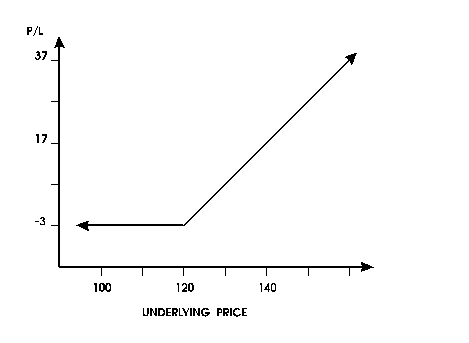
This graph looks just like the last one, with one difference;
both lines have been lowered 3 points to reflect the purchase
price.
If
we instead looked at a 115 call costing 5, we will get the
payoff diagram shown in Figure 3. The shape is the same, but
the lines meet in a different spot.
Rather
than graph every possible call, it will be easier to remember
that the general payoff diagram of a call has two lines: the
left one is horizontal, the right one has a slope of one,
and they intersect at the strike price. The horizontal line
passes through the P/L axis at the negative of the option
cost.
| Table 2: Profit and Loss on a 1.30 Pound Put |
|
|
|
| When the pound ends up at: |
You will have: |
For a profit/loss of: |
|
| 1.00 |
0.30 |
0.28 |
|
| 1.20 |
0.10 |
0.08 |
|
| 1.40 |
0.00 |
-0.02 |
|
| 1.60 |
0.00 |
-0.02 |
|
| 1.70 |
0.00 |
-0.02 |
|
Long
Put
Let's
produce some pound put pictures. If one buys a 1.30 put on
Sterling at a price of .02, the table of the value of the
put would be as illustrated by Table 2. This can be translated
into the graph shown in Figure 4.
After
drawing a few of these, it becomes apparent that a general
graph for puts may be drawn. It too has two lines. For a put,
the left one slopes downward from upper left towards lower
right, and the right is flat. Like a call, they intersect
at the strike price, and the line, if extended, would intersect
the P/L axis at the negative of the option premium.
Short
Positions
Options
are a zero-sum game. That means that an option buyer's gain
is the seller's loss, and vice versa (ignoring commissions).
Because of this, the payoff diagram of the dollar return from
owning an option must be the mirror image of the seller's
profit and loss. Whenever the previous payoff diagram are
positive (negative), the payoff of a short position in the
same option will be negative (positive). For example, the
table for a short position in a 1.30 put costing 0.02 is shown
in Table 3.
| Table 3: Profit and Loss on a Short Position
in a 1.30 Put |
|
|
|
| When the pound ends up at: |
You will have: |
For a profit /loss of : |
|
| 1.00 |
-0.30 |
-0.28 |
|
| 1.20 |
-0.10 |
-0.08 |
|
| 1.40 |
0.00 |
0.02 |
|
| 1.60 |
0.00 |
0.02 |
|
| 1.70 |
0.00 |
0.02 |
|
A
short put is presented in Figure 5. Note that it is Figure
4 flipped over.
Non-Option
Payoff Diagrams
Another
payoff diagram of interest is a long position in the underlying
asset. If that asset is trading at 100, the long position
in the underlying is shown in Table 4.
| Table 4: Profit and Loss from Holding the
Underlying Security |
|
|
|
| If the underlying ends up at : |
The profit/loss is: |
|
|
| 20 |
-80 |
|
|
| 50 |
-50 |
|
|
| 100 |
0 |
|
|
| 125 |
25 |
|
|
The
graph of this is Figure 6.
The
tabular representation of holding $100 worth of a one-year
U.S. Treasury bill for a year, purchased to yield 6%, is presented
in Table 5, with the associated graph presented in Figure
7.
| Table 5: Profit Over One Year from Holding
a Bill Yielding 6% |
|
|
|
| If the 'underlying' ends up at: |
The profit will be: |
|
|
| 20 |
6 |
|
|
| 40 |
6 |
|
|
| 100 |
6 |
|
|
| 1000 |
6 |
|
|
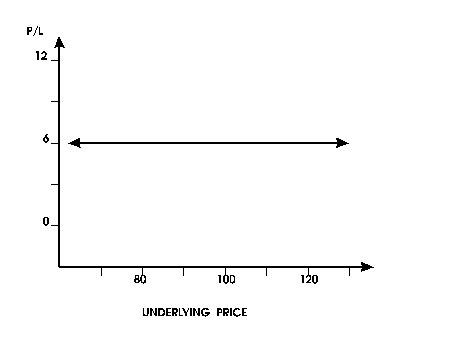
This
probably requires a little explanation. The point of the example
is that no matter where any asset is trading at expiration,
the investment is going to earn 6. There is no underlying
asset per se, since there is no option. We can think of the
left hand column as gold prices. Wherever it is trading in
a year, if you lend money at 6% for a year you will make 6%
on your money. No matter what.
Of
course, we have short positions in all of these, but they
will always be simple mirror images of long positions. We
should note here that these graphs are general in the sense
that the underlying asset is never identified. These could
be DM options just as easily as bond options. In addition,
time has implicitly been left of the graphs (except the T
Bill) because we are looking at the position value at expiration.
Option
Portfolios
With
payoff diagrams, we also can look at more complicated option
positions. It turns out that the payoff diagram of a complicated
option position is just the sum of the payoff diagrams of
each component of the position. For instance, we wrote earlier
about "straddling" the market when the pound sterling
was expected to be volatile. The person who took this position
was long both a put and a call. The payoff can be graphed
by adding together the payoff of a put and a call, and graphing
the sum. First, we derive Table 6. The payoff diagram of both
the put and the call is shown in Figure 8, and the payoff
diagram of the straddle is illustrated by Figure 9.
| Table 6: Profit and Loss form Holding a 1.60
Call and a 1.30 Put |
|
|
|
|
| Pound rate: |
Payoff of call: |
Payoff of put: |
Cost of call + put: |
P&L: |
| 1.10 |
.00 |
.20 |
.04 |
.16 |
| 1.15 |
.00 |
.15 |
.04 |
.11 |
| 1.25 |
.00 |
.05 |
.04 |
.01 |
| 1.35 |
.00 |
.00 |
.04 |
-.04 |
| 1.45 |
.00 |
.00 |
.04 |
-.04 |
| 1.65 |
..05 |
.00 |
.04 |
.01 |
| 1.85 |
.25 |
.00 |
.04 |
.21 |
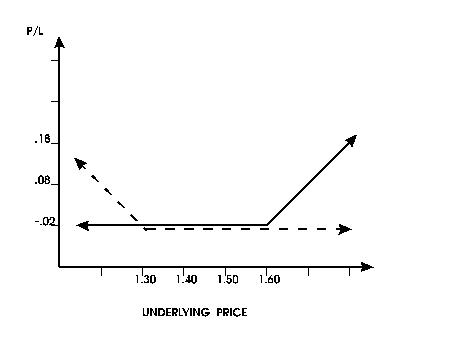
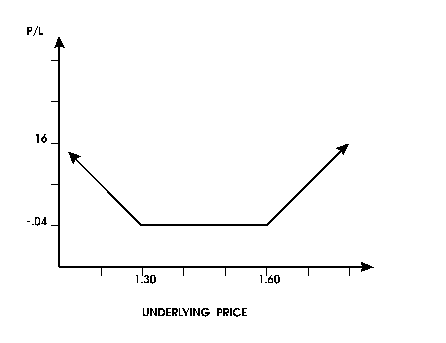
As
can be seen, adding the graphs is just as easy as summing
the numbers in the table. This way, all we need remember is
what the graphs of calls and puts look like. We can combine
them in any complex way by just drawing the payoff diagrams
of each component of the position, and summing. Thus, a position
that is long the underlying, long a 120 put, and short a 130
call, where the net cost of the options is 3, looks like Figure
10. 
If , as before, we had a 25 point profit to begin with we
can just raise the lines by 25 and the graph of total profit
would be as shown in Figure 11, which is exactly the same
result we stated earlier in this paper:
- a)
If the bond goes down, it can be sold at 120, locking
in a profit of 25 on the bond, less the options' cost
of 3, for a net profit of 22;
- b)
If the bond rises a little, say to 123, net profit would
be 28 minus 3, or 25;
- c)
If the bond rises sharply to 140, say, the investor will
be forced to sell it at 130 (the call will be exercised)
for a profit of 35 on the bond, less the options' cost
of 3, or 32 total.
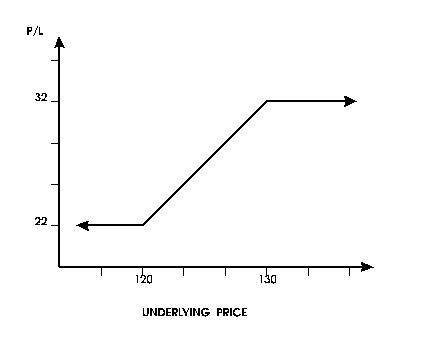
Thus,
using the concept of a payoff diagram not only allows us to
simplify the number of combinations of options strategies,
but it also makes it easier to assess the implications of
each.
ASSESSING
RISK AND RETURN
While
we can use a payoff diagram to view the possible returns on
an option position, it also is useful in examining the riskiness
of that position. For instance, knowing what levels the underlying
asset must achieve to reach profitability, one can then estimate
the probability of reaching those levels. This, then, allows
us to systematically state our probabilities of profits and
losses, as well as quantify their size. This is a very broad
topic, best addressed in a separate paper.
SUMMARY
Heightened
volatility in the financial markets and the growing global
interaction of those markets have made options an essential
element of institutional and corporate portfolios. This is
true no matter what opinion one holds on a particular market,
be they bull or bear, and regardless of one's appetite for
risk, be they lion or lamb.
This
paper has defined what options are, provided some examples
of their use and introduced a framework for evaluating both
individual options and portfolios of options. We also have
touched upon ways in which payoff diagrams may be employed
to measure risk. There is much more to be said on this topic:
how risk and return changes as markets fluctuate. While each
of these requires its own thorough treatment, the ideas presented
here lay down the fundamentals needed to understand options.
